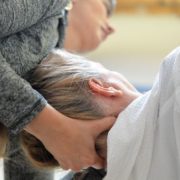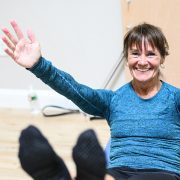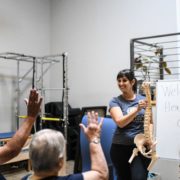Could your Hamstring Strain Actually be a Back Problem?
Have you ever strained your hamstring but the pain just doesn’t go away?
It’s been months since you first started hurting, you can’t actually remember how you injured it (it just started aching one day), you’ve been stretching and massaging it diligently, yet your hamstring still hurts.
This happened to a recent client of ours (“Sandy”).
Sandy was a runner and regular gym goer, who one day noticed an ache in her hamstring. She assumed she had just overdone it working out. She rested it a few days and the pain went away, but when she tried to get back to running she couldn’t. Her hamstring pain came right back. Thinking she hadn’t let it heal enough, she went back to resting it, but this time, decided to add some massage and stretching to her routine.
A few weeks later… you guessed it… Sandy still couldn’t run.
She also noticed the pain in her hamstring started to feel “different.” It was becoming more deep and achy and started to hurt all the time instead of only when she tried to exert it. It even hurt when she sat for too long. She still couldn’t run and was starting to get worried. Her doctor told her it was just a “strain” and that she had to let it heal. The problem was that it wasn’t healing. Several months had now gone by and she was running out of exercises and stretches to try that would “let it heal.”
Luckily, Sandy attended our recent back pain and sciatica class and realized that the pain in her hamstring might not be a strain at all.
And her instincts were right! Let me explain.
When you truly strain a muscle, it means you have done damage to your muscle tissue. Although it’s possible to have chronic problems from a strain that isn’t rehabilitated properly, strains typically do in fact heal. Once the inflammation from the tissue damage goes away, and you start doing the proper stretching and strengthening, your muscle eventually gets back to normal. Until a muscle strain is fully healed, it will typically be aggravated if you accidentally over-stretch it or exert it. But you usually don’t feel anything when you’re resting the muscle. In Sandy’s case, her hamstring was starting to feel worse when she was resting — the longer she sat, the worse she felt. Your hamstring is completely relaxed when you are sitting, so something wasn’t adding up.
This was the first sign we were likely dealing with something other than a “hamstring strain.” The second sign was that we could take her pain away by moving her back! Yes, you heard that right.
By moving and stretching her back in a specific way, we were able to significantly relieve the pain in her hamstring.
The reason her hamstring was actually hurting was because a nerve had been aggravated in her back. The nerve was causing pain to radiate into her thigh. That’s why it hurt when she sat for too long and it’s why she couldn’t tolerate any running. Sitting puts more stretch and pressure on the nerves in your back, and running puts a lot of compression through your back. Generally speaking, nerves don’t like to be stretched, especially aggravated nerves, and they don’t like to be compressed if they are aggravated either. By stretching her back in a very specific way, we were able to relieve the pressure from the nerve that was giving Sandy her “hamstring strain.” This confirmed that she was indeed having a back problem.
Has anything like this ever happened to you?
If you’ve got pain anywhere in your buttocks, hip, thigh, or leg that isn’t going away — especially if you’ve done your due diligence and tried all the “right things” — it’s possible you could have a back problem causing this pain instead. These types of back problems are easily missed if you don’t know how to accurately assess them and it won’t be picked up by an MRI or X-ray. The best way to figure this out is through specialized movement testing, like we did with Sandy.
We talked all about this in our recent back pain and sciatica class. If you want access to the recording, just call our office: 603-380-7902. If you want to take the next step and meet us in person — you can schedule a FREE Discovery Session with one of our specialists right here!











